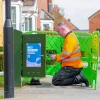More Norfolk UK Communities Confirmed for BT Superfast Broadband
The £41m Better Broadband for Norfolk scheme in England, which aims to make BT’s superfast broadband (FTTC/P) network available to 80% of local homes and businesses by the end of 2015, has revealed the next batch of roll-out areas and confirmed that over 50,000 premises have already benefitted.
The project, which is currently investigating how it can reach the Government’s new 95% coverage target by 2017 (Broadband Delivery UK has committed an extra £5.59m to Norfolk and the council are currently working on a plan to match it), ultimately intends to improve services for a total of 270,000 Norfolk premises.
Advertisement
Last summer the scheme announced a huge list of 71 communities that would benefit during the first few months of deployment (here) and since then we’ve identified a number of additional areas have also been added, including some parts of Bexwell, Hilgay, Downham Market, Bengate (Worstead), Little Cressingham, Meeting Hill (Worstead), Merton, North Walsham, Saham Toney, Spa Common, Threxton, Hunstanton, North Walsham and Watton.
The roll-out in many of these areas is on-going and this week’s latest update reveals that the next batch of areas to follow “later this year” will include properties in and around Fakenham, Dersingham, Heacham and Poringland, among others that have yet to be confirmed.
George Nobbs, Leader of Norfolk County Council, said:
“It’s impressive how much has been achieved by this public-private sector partnership in a relatively short space of time. Norfolk is ahead of most other counties that are part of the BDUK programme and we’re really starting to shed the ‘poor cousin’ tag in terms of our broadband connectivity. The importance of this cannot be overstated – it makes Norfolk a more attractive place to live, work and do business, increases educational opportunities and decreases social exclusion.
Better Broadband for Norfolk is largely focused on bringing better broadband to the county’s more rural areas – its villages and market towns. This means the number of properties that will benefit from each new fibre cabinet can sometimes be quite small, which is why public investment is necessary to make doing the work commercially viable.
We’re less than halfway through the programme with lots still to do but there’s no doubt that it’s making great progress, with new fibre cabinets going live every month and tens of thousands more properties set to be connected over the next few months.”
Admittedly Norfolk’s 80% goal might seem quite weak, especially as it falls well below even the central Government’s original superfast target for 90% by the end of 2015, although unlike many councils Norfolk does at least state that this is for superfast (25Mbps+) speeds and not just general “fibre broadband” (including sub-24Mbps speeds) coverage (i.e. the overall reach of BT’s hybrid-fibre network in Norfolk may in fact be closer to 90%).
Furthermore an announcement about their plans to extend beyond the current 80% target is due sometime this summer.
Advertisement
Mark is a professional technology writer, IT consultant and computer engineer from Dorset (England), he also founded ISPreview in 1999 and enjoys analysing the latest telecoms and broadband developments. Find me on X (Twitter), Mastodon, Facebook, BlueSky, Threads.net and Linkedin.
« UK Broadband Strong in Latest EU 2014 Digital Agenda Scoreboard

















































Comments are closed